














Sometimes building a stronger support network is all that’s needed
Friends, family and health care professionals can help you bounce back after having a bad day.

People may overlook
loneliness, brushing it aside as something unworthy of real scientific exploration and consistent personal attention. But this is a natural response to isolation, and feeling like a social connection has been lost can have very real impacts.
They say it takes a village to raise a child. The same
may also be said when trying to shake the blues. Surround yourself with helpful individuals who can provide the safety net we all sometimes need when life takes a difficult turn.
Experts have consistently proven that those who are
lonely deal with more mental health and physical problems than others with stronger connections. So, creating and maintaining positive relationships at home and at work can have a huge impact on our general well being. We’re also encouraged to reach out to professionals, as needed. People without
these important bonds may become more reclusive, turning inward to deal with their problems. Emotional and physical wellness may suffer if they feel unable to cope.
Depression sufferers have shown improvement with their symptoms once they started having more
positive interactions with the world around them. At the same time, those who experience loneliness increase their risk of early death by a whopping 50%, according to the American Heart Association. Being isolated was also shown to increase coronary artery disease and stroke risks by as much as 32%. Lonely people are often less active, and studies confirm that

those who eat alone tend to have a less healthy diet.
If you’ve found yourself isolated, as so many have after emerging from the quarantine era, there are ways to slowly reconnect with friends, extended family and your community. Start by joining a local club or church. Call up somebody you haven’t seen in a while and arrange a fun
activity. Rebook that longdelayed appointment with your mental health professional. Enroll in a fun class at the local community college, or sign up for a gym membership. Join a professional organization, where you’ll find people who share your work goals. Interacting with business owners or workers in your area can help smooth the way for a return to other social situations.
One of the lockdown era’s biggest pastimes still matters.
Before we knew exactly how COVID-19 spread, people were spending a whole lot of time scrubbing. It’s still a good idea in the fight against sickness and the spread of germs. A number of other conditions and diseases have been linked to dirty hands, either from improperly washing or not washing often enough. Scientists have determined the best process for effective cleaning, backed by numerous research projects and studies according to the Centers for Disease Control and Prevention. Those who don’t follow this simple protocol may be needlessly putting themselves at risk for negative health outcomes every day.
Troubling statistics show that some 2.2 million children aged 5 and under die annually from pneumonia and diarrheal diseases. The CDC says proper hand washing with soapy water would work as a crucial protectant: One in three wouldn’t get diarrhea, their research
indicates, while one in six of those children would be protected from pneumonia. They estimate that proper hand washing can reduce the instance of respiratory illnesses including colds by more than 20%. People with weakened immunity would see instances of diarrheal illnesses drop by nearly 60%.
Begin with a supply of clean, running water. Lather soap into your hands under the water, creating friction
as you scrub. Highest concentrations of microbes can usually be found under the fingernails, according to the CDC, so don’t forget to focus there along the way. Rub hands together for at least 20 seconds for best results, about the amount of time it takes to sing the traditional song “Happy Birthday” from beginning to end two times. Friction helps the soap lift germs and grime off the surface of your skin, which are then washed away by rinsing.
Most people assume that hot water is needed to best clean hands, but the CDC reports that water temperatures don’t appear to have any impact the removal of microbes. Always use clean running water when rinsing, since standing water may create a welcoming atmosphere for more germs that will then simply recontaminate your hands. Dry your hands immediately, since the CDC warns that germs are more easily transferred to and from wet hands.




Sedentary lifestyles can lead to a variety of worrisome health outcomes, including diabetes, mobility issues and obesity.
Sometimes, your busy work schedule plays a role. We can become so engrossed in what we do at our workstations that we never get up and move around. Some are so busy that they don’t even leave for lunch, eating right at their desks.
Break the cycle by getting
healthier while you work. Bring a few coworkers along as you make these important lifestyle changes. Like other office projects, it’ll be easier if you work together as a team.

remain seated, and other positions that require us to remain at a workstation keep us from moving around on a regular basis. Even those who hit the gym a few times a week still find themselves in a static position for hours on end. That can tip the balance,
even with a committed exercise routine. Then there are those who are so committed to work that they don’t feel they have the time for anything else other than rushing home.
Unfortunately, those who sit for lengthy periods of time are at greater risk for bone, joint and posture problems. Heart disease, stroke and diabetes are some of the conditions
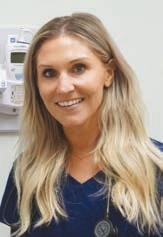

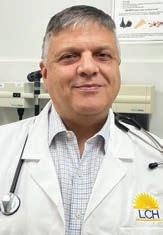
associated with sedentary lifestyles. Lower energy levels can hamper mental alertness, directly impacting your work.

Beginners may find that developing a solid plan involves weeks or months as you slowly incorporate more and more physical activity into your routine. In some cases, you may
have to get very creative in order to incorporate regular movement into your busy schedule. Start by adding “passive” exercise into your work life: Park further away from the building or, if possible, bike or walk to work. Take the stairs, rather than hopping on the elevator. Get up and walk over to a coworkers desk to discuss a project instead of simply emailing.
These small changes can have a big health impact – and you’ll be building endurance and strength. Next, incorporate regular exercise time, at home or at the gym. This may need to be immediately before or after work hours — or later in the evening, after other obligations at home have been dealt with. Some people even convert a portion of their lunch break.

WHEN YOU’RE PLAYING A BASEBALL GAME, YOU AREN’T THE ONLY ONE ON THE FIELD. EVERYONE HAS THEIR OWN STRENGTHS AND A POSITION THAT FITS THEIR ABILITIES. BY HAVING ALL SORTS OF PLAYERS ON THE FIELD, THE TEAM CAN ACCOMPLISH MORE TOGETHER THAN THEY COULD APART.
Cancer care is similar, and many oncologists, like Michael Costello, MD, Medical Director of The Abramson Cancer Center at Chester County Hospital (CCH), describe it as such.

“Cancer care has become a team sport, with many different team members surrounding a patient as they provide

necessary medical care,” Dr. Costello says. “Depending on the details of their specific cancer, many different medical specialties can be involved in a patient’s care.”
While Dr. Costello is a highly-skilled medical provider and leader, he isn’t the only one treating patients with lung cancer. There are many people who will be on
your cancer care team, working together to make sure you receive quality care.
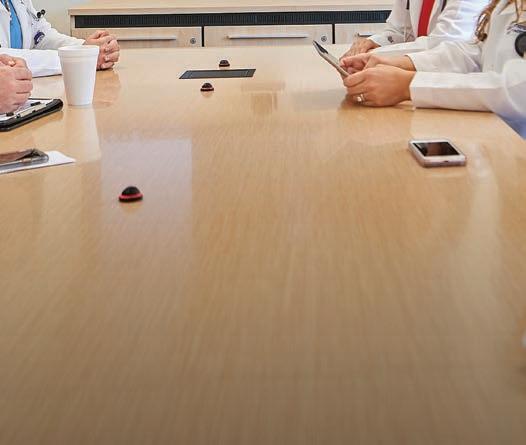

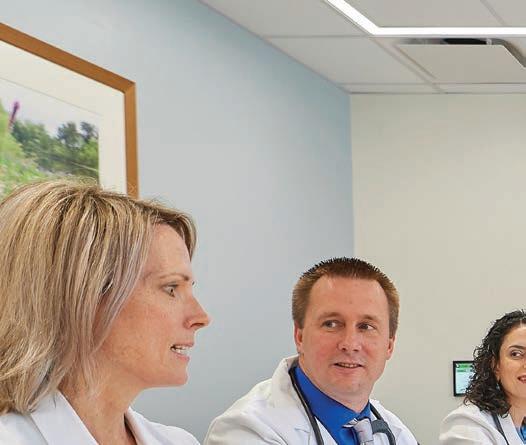
If you or a loved one has recently been diagnosed with lung cancer, you may wonder who will become part of your care journey. Here are some different medical specialists that might be on your cancer care team — and what they do.


Pulmonologist: A pulmonologist is one of the first people on your cancer care team. Pulmonologists specialize in the respiratory system, including your lungs. They establish a diagnosis for your lung cancer through either a bronchoscopy or other interventions like a CT-guided biopsy.
Pathologist: A pathologist is also involved in diagnosing lung cancer — though they’re more behind the scenes. Pathologists help review a lung biopsy specimen to understand if further study is needed before choosing the best treatment for a specific lung cancer.
Medical Oncologist: Dr. Costello is a medical oncologist, meaning he specializes in diagnosing and treating cancer. Medical oncologists are generally your primary provider throughout your treatment journey. They act as the coordinator for the different care you may receive from other medical specialists.
While you may be familiar with the cancer-related specialists on your cancer care team, many more individuals who will play a role in your care.
Here are some of the additional people at CCH ready to support you in your cancer care and treatment plan:
Nurse Navigators: Nurse navigators help you coordinate and schedule appointments and tests, provide information to you and your family, and act as the bridge between you and your clinicians.
Respiratory Therapist: To improve your overall quality of life, respiratory therapists provide you and your family with information about lung cancer. They also monitor your oxygen levels and — if needed — ventilators or other artificial airway devices that support your lung function.
Exercise Therapist: When you have
Thoracic Surgeon: A thoracic surgeon can perform surgeries and operations in the chest, like on your heart and lungs, that might be required to treat your lung cancer.

Radiation Oncologist: If you need to receive radiation therapy as a part of your cancer care, it will be overseen by a radiation oncologist. These medical specialists will meet with you to discuss your treatment plan, answer questions, and work with other members of your care team.
lung cancer, you may find difficulty completing specific tasks. Exercise therapists help you make and reach your health goals by creating a customized plan. This can include personalized education and supervised exercise sessions.
Nutritionist: Nutritionists are another crucial part of your team, helping to maintain your nutrition status throughout the duration of your care. Nutritionists can be involved in all treatment phases, ensuring you get enough vitamins and minerals through food.
Diabetes Educator: Sometimes, you may have lung cancer as well as diabetes or prediabetes. A certified diabetes educator helps you better understand and manage your diabetes during cancer treatment.
Smoking Cessation Counselors: If you have been diagnosed with lung cancer or have poor lung health due to smoking, you may decide to stop. The counselors in the CCH Smoking Cessation program can help.
Getting a lung cancer diagnosis can leave you with questions and worries — but the team at CCH is here to support you every step of the way.
“I don’t know a single person out there that hasn’t been touched by cancer in some way or form. It’s a disease that affects almost every family out there,” says Dr. Costello. “The relationships I develop with my patients are incredibly rewarding, as I see them through various phases of their care.”
From diagnosis to treatment, Dr. Costello and his team can provide the care you need to help you feel like the real MVP. If you have questions about your lung cancer diagnosis or lung health, make an appointment at The Abramson Cancer Center at Chester County Hospital by calling 610-738-2500 or visit chestercountyhospital.org/acc
Dr Michael CostelloMD
“Cancer care has become a team sport, with many different team members surrounding a patient as they provide necessary medical care”
Our health care system relies upon a continuously replenished reserve of blood in order to operate. It shouldn’t be so hard to meet that requirement. After all, almost everyone over the age of 17 is eligible to give blood. Yet doctors and nurses often struggle with huge defi-cits as too few donate because they misunderstand the need or the process. Others are simply unaware of how important this life-giving donation can be.

Here’s a look at why it’s no important, and how you can get involved.
Like any other charitable donation, there are feelings of community and goodwill asso-ciated with giving blood. But there’s more to it – much more – as your blood bolsters the sick and injured through health care emergencies and surgery. At the same time, there may be a health benefit for you, too. Donors are given a quick health check before giving blood, and there may be important health care indica-
tors found in the results. They check pulse and blood pres-sure, body temperature and hemoglobins. If your numbers are off, that could be an early sign that there are issues of your own to discuss with a doctor. Either way, you’ll potential-ly be saving a life.
First, you must be in good health. Other basic requirements for donation include age restrictions, which can depend on the state. You’ll also have to weigh a certain
amount. You may only donate once every 56 days, and up to six times per year. There is no upper age limit, so long as you’re well and there are no limitation on your activities. If you’re on antibiotics, they’ll evaluate to determine if it’s a bacterial infection since that could be transmitted by blood. Diabetics may donate, but there are certain restrictions for other health issues, includ-ing some cancers and HIV.
The American Red Cross
recommends that donors eat a light meal, and drink plenty of fluids before giving blood. Bring a driver’s license or other forms of identification, and the names of any medications you are currently on. Wear a short-sleeved shirt or one with sleeves that can be comfortably rolled up. If you’re feeling apprehensive, or are worried about your ability to drive after giving, bring a friend along for support. They’ll likely have a light snack and water, but bring your own if you’d like.
This simple, safe gift is often underestimated —

Your body naturally makes all the cholesterol that’s needed, but other factors can push us over the line. This waxy substance is found in many animal-based food sources, like red meat, poultry and dairy. When intake of those fat-rich foods gets out of balance, the liver produces more cholesterol — and that can collect in our artery system.
The heart has to work harder to circulate blood. If plaque breaks loose, it may create blockages leading to the brain that cause a stroke, while blockages around the heart can lead to a heart attack.
It’s critically important that we keep these numbers in check in order to live healthier, longer lives. Here’s a look at the types of cholesterol, and how they impact our health:
Turns out, not all cholesterol is bad. It’s just that too much or one kind of cholesterol can put you in jeopardy of a serious heart problem. So
can having not enough of the other kind of cholesterol. Low density lipoprotein, or LDL, is typically described as “bad” cholesterol, while high density lipoprotein is “good.” Doctors will also keep an eye on triglycerides, another form of fat made in the body. These numbers might be elevated based on being overweight, physical inactivity, diabetes, smoking, alcohol consumption, or eating too many fats or carbs.

Dietary choices aren’t the only things to keep a close
eye on: Smokers and those with high blood pressure and diabetes are also at higher risk of heart disease. Cholesterol levels can also be impacted by age, gender and family history. Any of these factors may lead to deposits of thick, hard plaque that narrow the arteries, in a process known as atherosclerosis.
Your doctor will take regular measurements of your cholesterol in order to create a baseline, then make recommendations
if the results don’t align properly. This will be done with a blood test, and that may require a short fast beforehand. After the numbers have been run, you could be encouraged to make different dietary choices, create or increase your activity regimen, or perhaps begin regularly taking prescriptions. These medications would play a critical role in lowering your risk of stroke and heart attack, depending on your specific situation, so follow the doctor’s instructions to the letter.

When it was first established as a practice in 2006 in West Grove, the mission at Jenny Chen Pediatric and Family Dentistry was very simple: To become a world class dental practice that provides outstanding service to the individuals and families it cares for.
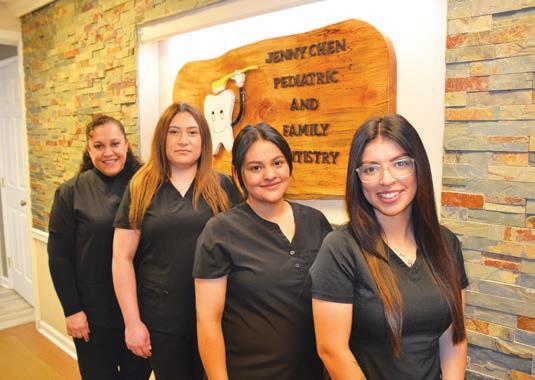
While the practice consistently delivers on that
mission 18 years later, it does so with a philosophy that believes every smile is special, from childhood through adulthood -- one patient, one family and one community member at a time. While it embraces that latest in dental technology, the long-term success of the practice is also measured by its many intangibles: its caring and diverse staff who
is fluent in English, Spanish, Arabic and Chinese; its Give Kids a Smile program that provides dental care to under privileged children once a year, free of charge; its willingness to take a weekend phone call and handle an emergency dental emergency visit; and most of all, its compassion and care for the diverse community it serves.
“We have begun to see our fourth generation of families, and all of them refer to us as ‘their dentists,’” Dr. Jenny Chen said. “Every one of us here takes an enormous amount of pride in that distinction. Each patient begins with me and then based on our recommendations, he or she branches out to our many areas of specialization – General dentistry, orthodontics, cosmetic and implant dentistry, implants crowns and bridges and orthodontics -- and when they see the transformed
healthy smiles, they often refer bring their family and friends with confidence. From standard dental services and preventative care to restorative solutions and creating a beautiful smile, the staff at Jenny Chen Pediatric and Family Dentistry is fully committed to taking care of their patients’ needs, beginning with its team of doctors. “Dr. Jenny” Chen is proficient in all aspects of dentistry, including cosmetic dentistry, implant restorations, pediatric dentistry, extractions, root canal therapy, dentures, and crown and bridge. Dr. “Dr. C” Ahmad F. Charkas specializes in a wide array of orthodontic techniques, from standard braces to Invisalign for both children and adults. Dr. C has been transforming smiles for more than 9 years in our office and is happy to treat patients and their children at the same time.
Dr. Robert Delie, who has been with Jenny Chen Pediatric and Family Dentistry for the past year-and-a-half, is a periodontist with over 20 years of clinical dentistry and currently specializes in implant dentistry and periodontal surgery. Dr. Delie provides anxiety-free implant placement to many patients that restores their chewing function and smiles. Dr. Jenny Chen’s staff is very


passionate about building beautiful smiles and creating a relaxed atmosphere in the office, and go above and beyond to make patients feel like family.
Jenny Chen Pediatric and Family Dentistry uses the latest in advanced dental technology, including digital X-rays to reduce radiation, an intraoral scanner to that can produce a 3-D image of the mouth and eliminate

impressions and improve treatment planning, and an oral CT scanner which can make dental treatment safer and more accurate.
As it embarks on its 18th year in West Grove, Jenny Chen Pediatric and Family Dentistry can best be defined as a foundation of dental care.
“Over the years, we have worked with many patients who were too embarrassed
to smile at first, but when we see them now, they’re smiling and opening up and experiencing wonderful life changes,” Dr. Jenny said. “They tell us, ‘I have so much more confidence in myself since I was able to smile again.’ A smile can change a person’s life, and with gentleness and our commitment to developing trust, we get to play a big part in that.”
Jenny Chen Pediatric and Family Dentistry is located at 207 North Guernsey Road, West Grove. For more information, visit the website at www.smilesinpa.com or call the office at 610-869-0991 to speak with bilingual staff.
Jogging has numerous physical and mental benefits, and it’s an activity you can do alone or in a group.
Hitting the streets provides some immediate health bene-fits, and some
Regular jogging sessions can improve heart and immune function, lessen stress and anxiety, help with maintaining flexibility and may help you lose weight with the proper diet modification. As little as 1 to 2.5 hours of jogging a week,

even at a slow or moderate pace, can also lead to big dividends when it comes to longevity. An extensive Danish study found that regular jogging increases men’s life expectan-cy by more than six years, while women’s jumped more than 5.5.
Another study confirmed that any amount of running was associated with a 30% decrease in the risk of dying from heart disease — a critical element, since heart disease is responsible for so many deaths world wide. Running helps fight blood clots in
blood ves-sels and arteries, while also supporting healthy blood pres-sure and diminished cholester-ol. Jogging also translated into 23% less risk of dying from any form of cancer.
Runners force their cardiovascular system to generate more capacity, opening more small arteries and capillaries to help lower
blood pressure. Jogging lowers your blood sugar, decreases inflamma-tion and stimulates our brain. (One researcher noted that vigorous physical activity has proven to be the best preventative so far against Alzheimer’s.). Running also helps regular hormone levels, maintain healthy weight and speeds up digestion, a trio of processes that can have big health impacts.

Novices should gradually increase their intensity, rather than trying to immediately jog long distances. Walking will improve your physical readiness: Once you can briskly walk for two hours without tir-ing, begin short intervals of running. Try 10 minutes at first, and gradually increase to 30 minutes. Continue lengthening the time you run, with shorter intervals of walking,
until you’ve found a comfortable pace.
Researchers noted that the best results were, in fact, at this slow or moderate pace — and for no more than 2.5 hours per week. Those who jogged longer and especially those who ran at a higher- than-average rate actually had worse longevity outcomes. Slow and average runners fared better.
Like most things, sweets are fine in moderation. But if you find yourself regularly indulging, you could be setting yourself up for some serious health risks.

Even if you don’t eat candy, you still might be getting far too much sugar in the form of added ingredients in items like soda, canned fruits, smoothies and yogurt. Worrisome government statistics have shown that U.S. adults are getting as much as 13% of their daily calories from sugar.
Sugars are always found in food that also contains carbohydrates, including grains, dairy, some vegetables and fruits. These naturally occurring sugars are perfectly healthy because whole foods and dairy also contain high amounts of things like fiber, proteins, calciums, minerals and antioxidants. The body digests these things more slowly, leaving sugar to provide energy in the meantime. Problems occur when you ingest too much
sugar, in particular sugars added by manufacturers in an effort to extend shelf life or increase flavor.
Excessive consumption of sugars, in candy and as an added ingredient, may create an imbalance in your bloodstream that causes irreparable damage to your liver. Diabetes then leads to other severe health problems. There is a clear relationship between high-sugar diets and cardiovascular health. One 15-year study showed that those who got between
17-21% of their daily calories via added sugars had a 38% higher risk of dying from heart disease compared with those who followed guidelines. Ingesting excess sugars also leads to obesity, since our bodies begin storing calories when they’re not immediately needed. Those who are grossly overweight are then at risk for related health issues like high blood pressure and heart disease, among others.
Added sugars should be limited to half of your daily recommended sugar intake,
according to the American Heart Association. For most American men, that equals no more than 150 calories. For most women, it’s no more than 100 calories. That can be harder than you think: Candy and many other top sources for added sugars are obvious sources for extraneous calories, but these sugars are also found in soups, cured meats, bread and ketchup, among other products. The National Cancer Institute has estimated that average adult male currently takes in about 385 calories in added sugar per day.

Every situation is different, so keep a first aid kit handy when you’re outdoors. Then be ready to make a quick assessment since the first few minutes are so crucial.
Because of their everyday proximity, domestic pets end up biting humans the most often — and dogs, the Mayo Clinic confirms, are far more likely to cause injury than cats. Cat bites are more likely to cause infection, however, since they cause thinner, deeper puncture wounds that may be more difficult to thoroughly disinfect. Next on the list of most common bites are the more troubling nonimmunized domestic animals like squirrels, rodents and rabbits, since they may have rabies. In those situations, seek medical attention immediately. Roughly 5 million people are bitten by snakes worldwide each year, most of them in southeast Asia and in Africa. See a doctor as soon as possible since anti-
venom treatments may be appropriate.
For minor wounds, wash as thoroughly as you can with soap and water. Then apply an antibiotic, placing a clean bandage over the wound to protect it from infection. For deeper wounds, the first order of business is to stop the bleeding. Apply pressure with a dry, clean cloth. Whether you should drive or be driven to seek medical attention depends on the severity and location of the
wound. You may need to call 911 in certain emergency situations. For snake bites, immobilize the body part, then see a doctor. But do not apply a tourniquet or open the wound since that can worsen the effects.
Be on the lookout for infections. If you notice redness, swelling, oozing or increasing pain, have the wound checked by a doctor as soon as possible, since those are clear warning signs. If you’ve
suffered a dirty or deep bite, medical professionals may recommend a tetanus booster — especially if your last shot was five or more years ago. (The Centers for Disease Control and Prevention recommends getting these shots every 10 years.) If you discover that you or those in your hiking or camping party were sleeping in the presence of bats, seek medical care. Their bite marks are difficult to spot, so you may have been bitten by a bat and be at risk of rabies without knowing it.
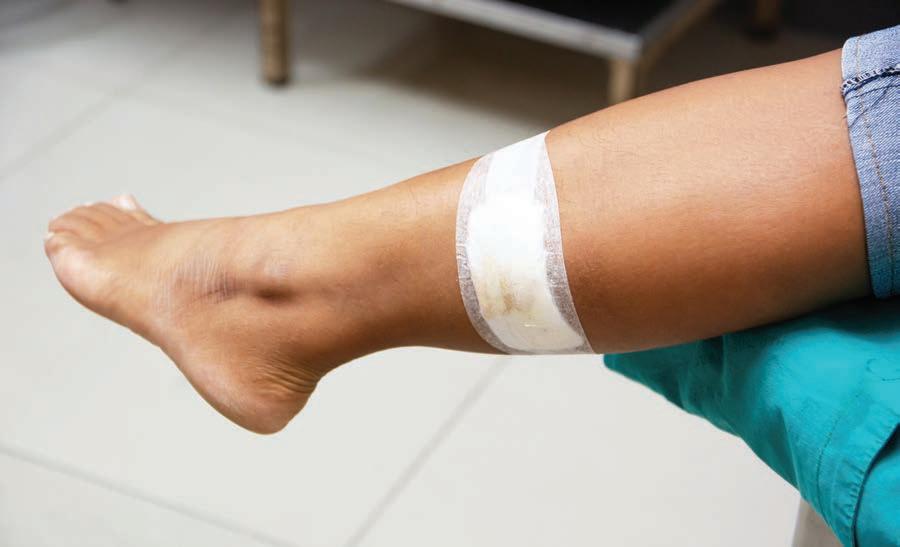

best way to slow down these days is sometimes to turn it all off.
Stress impacts our wellness in so many unseen ways, with smartphones, laptops, tablets and
flatscreens creating frenetic surroundings that never allow us to completely relax. Taking a break can lower our blood pressure and rebalance our emotions, while helping us reconnect with the people and places that surround us. You may discover that technology

is also interfering with your ability to get enough rest, a common issue according to the National Sleep Foundation. Multiple studies have shown that making even small improvements in these areas can have lasting positive health impacts.
A study conducted by Utah Valley University confirmed that too much time spent on social networks can directly cause stress, often in the form of user envy. Those dealing with their own issues, at home or at work, may become jealous or vengeful
when they see others posting positive updates from their own lives. The pressure to keep up with the accomplishments of others may be overwhelming for others, according to the study.
If you suspect that you’re overly reliant on technology, start tracking how often you check your Facebook account, Twitter feed and
email every day. Compare that with the number of meaningful conversations you hold with family and friends. If there is a noticeable discrepancy between one and the other, it may be time to set some sort of limit on how much you’re using technology. Consider returning emails only during certain timeframes. Check private messages and notifications during scheduled times,
too. Smartphones also have handy do-not-disturb features that allow for long periods of quiet in order to reset.

Set the laptop or tablet aside, unplug the headphones and close out all of your apps. Consider a return to the simpler things that life used to entail, whether that’s reading a
book, working the garden, taking an afternoon hike, bird watching or just going for a long bike ride. It’s still a good idea to have a smartphone with you, in case you need to take pictures, make an emergency call or reference a map on hiking or camping trips, but otherwise leave it in your pocket, purse or backpack. Exiting off the information superhighway every once in a while can be a real life saver.
Get the most out of newly expanded employer health programs.
Medical costs are going up for everyone, including businesses. Health care coverage is more expensive, and modern-era Affordable Care Act stipulations have played a role, as well.
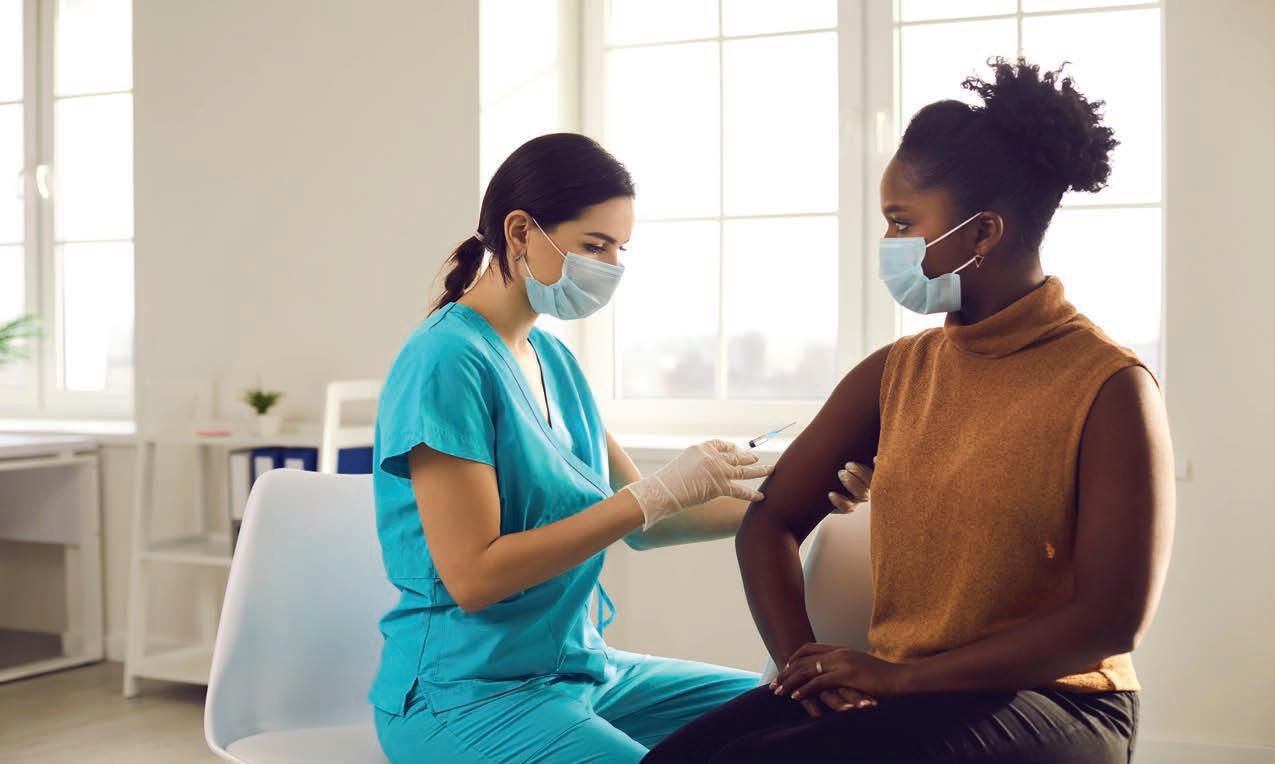
But companies aren’t simply incentivized to help their staff stay healthy in order to cut down on insurance costs. They also are focused on morale and lost man hours. One way employers are looking to drive down these expenses, while also ensuring workers are living happier, longer lives is through innovative wellness programs.
These programs have come a long way. Today, they illustrate how getting — and staying — healthy can be a fun and collaborative experience at work.
Companies are sponsoring charitable runs or walks, fun sporting events and wellness goal-setting competitions in an effort to engage with everyone. This is a significant
shift from the past, when employer health programs were geared more toward education than engagement. Some companies are bringing medical providers to their workers, sponsoring clinics or nurse visits to share information, advice and some preventative care like screenings and shots. Other initiatives include coordinating with health
care professionals or expert speakers to discuss issues of importance to staff during on-site presentations.
These programs often now include incentives beyond the result of healthier, happier lives. Corporate health programming, in some cases, will offer gift certificates, invitations to social events or even bonuses for reaching

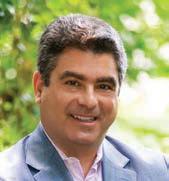
certain benchmarks. Others have goal-based rate incentives relating to better lifestyle choices, including smoking and excessive alcohol usage. In this way, aligning cost goals with staff wellness helps everybody’s bottom line.
Surveys and corporate health program apps help track how staffers are doing,


pairing biometric screenings or personal input data in order to follow trends like blood pressure, body-mass index and cholesterol levels. Beyond setting a baseline for incentive-based rewards, this information can also help medical professionals develop new programs to address looming health care issues. Companies may then create informational meetings, hand-out
materials and goals based on things like smoking cessation, obesity rates or medication adherence. It all works in concert toward lowering health-care costs, absenteeism and disabilityrelated work stoppages, while at the same time encouraging higher productivity. Ultimately these programs can play a role in boosting employee loyalty and job satisfaction, too.



Unfortunately, it’s a slow-growing cancer which may not have symptoms.
Tens of thousands will be diagnosed with cervical cancer this year, according to the National Cancer Institute. Thousands of them will unfortunately die. Early detection is the key.
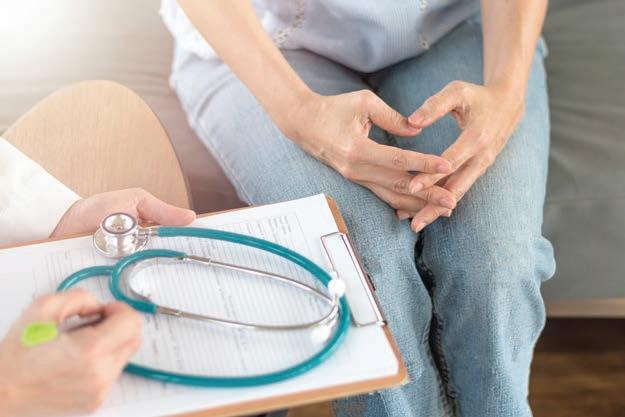
The cervix is the lower
portion of the uterus, which connects to the vagina. The National Cancer Institute reports that cancer in this organ is caused by human papillomavirus, the most common sexually transmitted disease in the U.S. The issue begins with pre-cancerous cells, which may or may not lead to a cancer diagnosis. A shift from pre-cancerous to cervical cancer typically takes several years, but the American Cancer Society warns that some patients move through
this process in a much shorter time frame. Regular testing can save lives.
Improved early detection through so-called Pap tests has helped drive down cervical cancer rates at a dramatic pace: In fact, both incidence and death rates fell by more than 60% in the first 30 years after its introduction in the ‘50s. Named after the doctor who invented the procedure, the Papanicolaou test involves microscopically examining a
small sampling of cervical cells in order to identify any looming issues. Screening is recommended by the U.S. Preventative Services Task Force beginning at the age of 21, regardless of sexual activity.

Once diagnosed, treatment options for cervical cancers include chemotherapy or radiation therapy, immunotherapy, surgery and vaccine therapy. These treatments may be employed individually or,
on a case by case basis, in combination with one another. Unfortunately, some treatment options may lead to infertility. Those who would one day like to become pregnant should discuss this possible outcome with the doctor. Storing eggs or embryos may be recommended before treatment starts.
Any cancer diagnosis can bring with it a variety of emotions, from anxiety and anger to sadness and worry.
Cervical cancer brings its own unique challenges, since it’s associated with HPV. Some may find it difficult to discuss their illness, symptoms or emotions because of the fear that others will connect behavior with the disease. In that case, a counselor, oncology social worker or clergy member might provide a better early sounding board. You can also called 800-813-HOPE or email info@cancercare.org to talk directly to oncology social workers.
Experts confirm what we already know: We’re eating badly, and we’re eating too much.
The U.S. in general does poorly in these rankings, and some states typically do worse than others, as well. Taken together, the numbers seem to paint a grim portrait. But we can turn these poor showings around, with one personal choice at a time. They really do start to add up over time.
The diet of a typical American is often weighted toward unhealthy choices. We get more than the recommended daily limits on calories derived from added sugars, refined grains and solid fats. These diets also exceed recommended levels
of sodium and saturated fat. Often times, the problem is simply the result of dietary choices. We don’t eat enough fresh vegetables, fruits and whole grains. As a result, the Centers for Disease Control and Prevention reports that the nationwide obesity rate has doubled since 1990.

Average daily intake keeps rising, by hundreds of calories, even as we produce a surplus of available food for consumption. Often times, the extra calories are derived from very familiar places: fast-food restaurants. These franchises have more than doubled since the 1970s. The problem is made worse by an over-reliance on processed and packaged foods, coupled
with sugary drinks. They’re more often consumed by those from so-called “food deserts,” where millions of Americans — including their vulnerable children – live too far away to regularly shop at a supermarket.
Sodium intake continues to be a huge issue in America, with many adults consuming more than 1,000
milligrams a day above the federal guidelines. Total fat intake has also skyrocketed, doubling since 1980. Blame often goes to soda, dairy and grain desserts, pizza and fried foods, but there aren’t always convenient choices to eat healthier. That’s led to a focus on correcting food deserts, and in addressing the growing number of families who suffer from food insecurity.
In the meantime, West Virginia (38.1%), Mississippi (37.3%), and Oklahoma (36.5%) had the highest obesity rates, while the least obese places were led by Colorado (22.6%) the District of Columbia (23%) and Hawaii (23.8%), according to the CDC. Even though Coloradoans fare best, those numbers are still up 7.6% since 1990.
Residents have the comfort of knowing that they can receive personal care without having to move. Care is brought to them. Quality of life, combined with a comfortable setting, makes Friends Home unique. It is the residents who fill the community with their vitality and spirit that make this a very special place, indeed.



Research shows that many chronic issues are preventable if you stay on top of scheduled visits and wellness checks. Your physician will run regular screenings to track high blood pressure, diabetes, weight gain, vision problems and cancers, among others. Discuss any other concerns you may have based on how you’re feeling, and they may suggest other tests.
Here are some of the most common screenings you’ll undergo.
Women between 30 and 65 should have Pap and HPV screenings every five years. Pap tests collect cells from the cervix in order to test for cervical cancer. Most of those who receive abnormal cervical results are either experiencing early changes that can be monitored or will be diagnosed with human papillomavirus infections, according to the National Cancer Institute. Routine exams will also discuss how you’re feeling in order to gauge the onset of depression. Women should have yearly
mammograms, since clinical breast exams save so many lives. Other tests or the frequency of testing may be impacted by any chronic diseases you may be suffering, or considered at high risk of contracting.
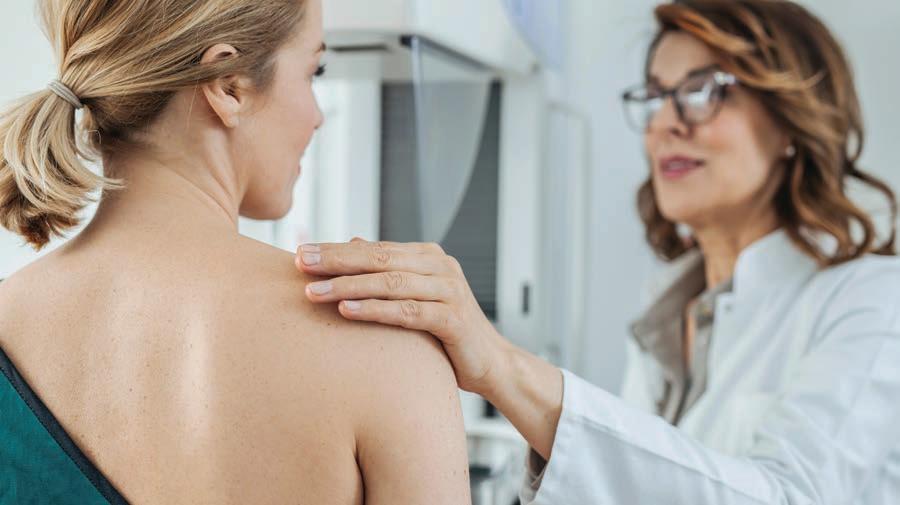
Regular blood pressure screenings are recommended, in particular for those with readings that are higher than 120/80, according to the experts. Men 35 and older should be checked for lipid disorders, and those younger if they are at high risk of
coronary artery disease. These fats include so-called “bad cholesterol,” or low density lipoproteins, as well as fatty acids known as triglycerides. High lipids are associated with diabetes, kidney and liver disease, and hypothyroidism.
Talk to your doctor about prostate cancer screenings, the timing of which can vary depending on health and age factors. You’ll either undergo a digital examination or a prostate-specific antigen test. Men between 65 and 75 who have smoked should get tested for abdominal aortic aneurysms, which when ruptured can lead to severe or
even deadly internal bleeding.
Adults should be checked for diabetes every three years, in particular if you have high sustained blood pressure of 135 over 80. Everyone should undergo regular baseline comprehensive vision exams. Colorectal cancer screenings are also recommended as we age. Discuss your risks with a health care provider, who will help you make informed decisions about these and other screenings. Your current medical condition and specific family history will play a role in deciding.

Blame exposure to everything from the environment to pets, from medications to food. But there’s a way to avoid certain irritants, and to lessen the impact of the sneezing, scratchy throats and itchy eyes which may follow. If left unchecked, sufferers are at risk for more serious health issues.

Talk to your doctor if you begin to experience a new allergic reaction — or if your symptoms seem to be worsening. In some very serious cases, a visit to a local emergency room may be required to get more immediate care.

Allergies are actually the result of our immune system’s overreaction to foreign substances, according to the Mayo Clinic. Our antibodies identify these substances as harmful, even though they may not be. The most common allergies involve many everyday found things. Airborne allergens include animal dander, pollen, mold and dust mites. Certain foods may also produce a reaction, including wheat, peanuts, seafood, tree nuts, milk and eggs, among others. Many are allergic to insect bites or stings, including bees, ant and wasps. Penicillin and other related antibiotics are
allergens for some. Latex is a common skin irritant.
In most cases, the symptoms of an allergic reaction mimic a cold. The difference is in how quickly these reactions take hold. You may quickly develop a runny nose, itchy eyes, rashes, swelling, sneezing or breathing problems as your immune system cranks up. Check for sensitivities and talk to your doctor about any family history with allergies. Many of these reactions are minor, but in the severest of cases a lifethreatening situation known as anaphylaxis may occur. In that case, immediate medical care is needed.
Unfortunately for sufferers, there is no cure for allergies. Still, you can help lessen the occurrences through avoidance, deep cleaning and certain treatments. Allergy meds, including antihistamines and nasal-saline sprays, are typically effective — even at overthe-counter strengths. Check with your doctor, however, before starting any regular regimen of medicine. You may have to avoid time spent with certain pets. For those with a sensitivity to mold, better ventilation and the use of a dehumidifier can reduce moisture. More frequent housecleaning and bedding wash schedules can lessen the impact for those who react poorly to dust or mites.
It’s amazing how much misery can be associated with everyday interactions

Your pharmacist is a health care professional who can play an important role in your health if you understand his role.
ExploreHealthCareCareers.org says pharmacists are, “medication experts and play a critical role in helping people get the best results from their medications,” and calls them one of the most accessible health care professionals, with most people in the U.S. living within 2 miles of a pharmacy.

Pharmacists usually have a doctor of pharmacy degree, complete a one- or two-year on-the-job training period and must pass two licensing exams. They may choose to further specialize their career by becoming board certified in a particular area, such as ambulatory care, psychiatric care, infectious diseases or oncology.
A pharmacist’s basic role is to check prescriptions before dispensing medication to patients, to be sure a patient receives the correct drugs and dosage to ensure
safety. Pharmacists keep patients’ allergies and other medications they are taking in mind, to be sure they won’t have an adverse reaction. They answer questions patients might have about drugs and any side effects they might experience.
Most people are aware of those parts of a pharmacist’s job, but did you know your pharmacist also may offer consultation services for the management of complex diseases, such
as diabetes, hypertension or arthritis, or give general advice on diet, exercise, and managing stress? That’s according to an article in the Journal of Advanced Pharmaceutical Technology & Research, which examined a pharmacist’s role in the health care field. Pharmacists also may educate other health care professionals such as physicians or nurses about pharmacologyrelated issues or medication management and contribute
most in the campaign to stop the inappropriate use of antibiotics, habit-forming and aphrodisiac drugs, according to the article.
Pharmacists also listen to patients’ symptoms and recommend over-thecounter medications to help. Before you message your doctor about an overthe-counter medication, first consider asking your pharmacist. They probably will be able to offer the advice you need.





